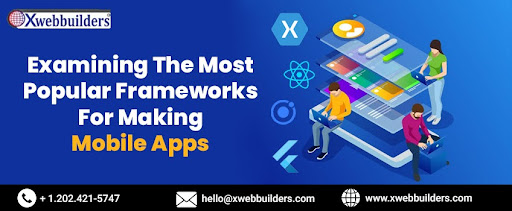
September 01, 2025

In today's digital age, mobile apps have become an integral part of our daily lives. To create high-quality and efficient mobile apps, developers rely on frameworks that provide a foundation for app development. These frameworks offer a set of tools, libraries, and guidelines that streamline the app development process. Examining the most popular frameworks for making mobile apps allows developers to make informed decisions about the technologies they choose. By understanding the strengths and weaknesses of different frameworks, developers or any mobile app development agency can select the most suitable option to build robust, feature-rich, and user-friendly mobile applications.
Xamarin is a popular cross-platform development framework that allows developers to create native mobile applications for iOS, Android, and Windows using a single codebase. It was acquired by Microsoft in 2016 and has since gained significant traction among developers due to its versatility and efficiency. Here is an overview of Xamarin and its key features:
- Cross-Platform Development: Xamarin allows developers to write code in C# that can be shared across multiple platforms. This means that developers can build native mobile applications for iOS, Android, and Windows simultaneously, reducing development time and effort.
- Native Performance: Xamarin enables developers to create native user interfaces and leverage platform-specific APIs, resulting in high-performance applications. Unlike hybrid frameworks, Xamarin apps are not web-based but instead utilize the native capabilities of the target platform.
- Code Reusability: With Xamarin, developers can achieve a high level of code sharing. Around 75% to 90% of the codebase can be shared across different platforms, reducing maintenance costs and improving development efficiency.
- Native API Access: Xamarin provides access to the full spectrum of native APIs and UI controls, allowing developers to create apps with the same look, feel, and functionality as their platform-specific counterparts.
Flutter is an open-source UI software development kit (SDK) created by Google that allows developers to build high-performance, cross-platform applications for mobile, web, and desktop from a single codebase. It has gained significant popularity among developers due to its fast development cycles, expressive UI, and native performance. Here is an overview of Flutter and its key features:
- Cross-Platform Development: Flutter enables developers to create applications for multiple platforms using a single codebase. This means that developers can write code once and deploy it on iOS, Android, web, and desktop platforms, saving time and effort.
- Dart Programming Language: Flutter uses the Dart programming language, which is developed by Google. Dart is easy to learn and offers features like a just-in-time (JIT) compiler and a ahead-of-time (AOT) compiler, enabling fast development and efficient execution.
- Hot Reload: Flutter's hot reload feature allows developers to instantly see the changes they make to the code reflected in the app's interface. This significantly speeds up the development process and enables developers to experiment and iterate quickly.
- Rich and Customizable UI: Flutter provides a wide range of customizable widgets and pre-designed UI elements that can be easily tailored to match specific design requirements. This allows developers to create visually appealing and highly interactive user interfaces.
React is a popular JavaScript library for building user interfaces. Developed by Facebook, React has gained significant traction among developers due to its component-based architecture, efficient rendering, and reusability. Here is an overview of React and its key features:
- Component-Based Architecture: React follows a component-based approach, where UIs are broken down into reusable components. This modular structure enables developers to create complex user interfaces by composing smaller, self-contained components, resulting in cleaner and more maintainable code.
- Virtual DOM: React utilizes a virtual DOM (Document Object Model) to efficiently update and render UI components. The virtual DOM is a lightweight representation of the actual DOM, allowing React to perform minimal updates when changes occur. This results in faster rendering and improved performance compared to traditional rendering approaches.
- JSX Syntax: React uses JSX (JavaScript XML), an extension to JavaScript, which allows developers to write HTML-like code within JavaScript. This enables a more declarative and intuitive way of defining UI components, making it easier to understand and maintain the code.
- Unidirectional Data Flow: React follows a unidirectional data flow pattern, where data flows in a single direction, from parent components to child components. This ensures predictable and manageable state management, making it easier to debug and test React applications.
Ionic is a powerful open-source framework used for building cross-platform mobile applications using web technologies such as HTML, CSS, and JavaScript. It provides developers with a comprehensive set of tools and components to create native-like mobile applications that can run on iOS, Android, and the web. Here is an overview of Ionic and its key features:
- Cross-Platform Development: Ionic allows developers to build applications that can run on multiple platforms using a single codebase. This saves time and effort as developers don't need to write separate code for each platform, reducing development costs and ensuring consistency across different devices.
- Native-like User Interface: Ionic offers a library of pre-designed UI components and themes that provide a native-like experience to users. These components are optimized for mobile devices and can be easily customized to match the application's design requirements.
- Cordova Plugins Integration: Ionic integrates seamlessly with Apache Cordova, allowing developers to access native device features and functionalities through a wide range of Cordova plugins. This enables developers to leverage device capabilities such as camera, geolocation, contacts, and more, enhancing the functionality of their applications.
- Angular Integration: Ionic is built on top of Angular, a popular JavaScript framework for building web applications. This integration allows developers to use Angular's powerful features and capabilities, such as dependency injection, component-based architecture, and data binding, to create robust and maintainable mobile applications.
- Performance Optimization: Ionic utilizes a hybrid approach that combines the power of native APIs with the flexibility of web technologies. It leverages hardware acceleration and optimized rendering techniques to deliver fast and responsive applications.
- Community and Plugin Ecosystem: Ionic has a large and active community of developers who contribute to its growth and development. The community provides extensive support, resources, and plugins that extend the functionality of Ionic applications. This ecosystem makes it easier for developers to find solutions, troubleshoot issues, and enhance their applications.
- Developer Tools and CLI: Ionic offers a command-line interface (CLI) and developer tools that streamline the development process. The CLI provides a range of features such as project scaffolding, code generation, live reloading, and debugging, enabling developers to be more productive and efficient.
- Progressive Web App (PWA) Support: Ionic allows developers to build Progressive Web Apps (PWAs) that can be installed on users' devices like native apps. PWAs provide an app-like experience through web browsers, enabling offline access, push notifications, and other native-like features.
In conclusion, examining the most popular frameworks for making mobile app development is crucial for any mobile app development company seeking to build efficient, high-quality applications. Each framework offers unique features and advantages, catering to different development requirements. By evaluating these frameworks, developers can make informed decisions, selecting the most suitable one based on factors like development expertise, project requirements, and target platforms. This ensures the successful creation of mobile apps that meet user expectations and deliver an exceptional user experience.For more information or to avail services of our mobile app development company Ashburn USA, visit Xwebbuilders.com .